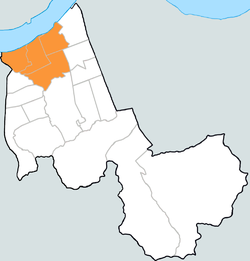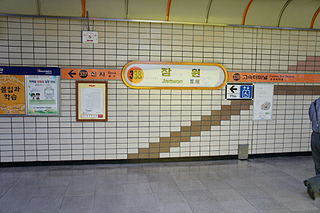
Jamwon Station is a station on the Seoul Subway Line 3. It is located in Jamwon-dong, Seocho-gu, Seoul.

Yangjae Station is a station on the Seoul Subway Line 3 and Shinbundang Line. It was the southern terminus of Line 3 until October 30, 1993, when the line was extended to Suseo station, and it became a transfer station with the Shinbundang Line on October 28, 2011. It is located in Yangjae-dong, Seocho and Gangnam District, Seoul.
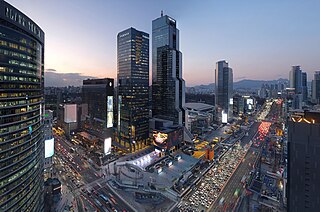
Gangnam District is one of the 25 districts of Seoul, South Korea. The term Gangnam translates to "South of the [Han] River". Gangnam District is the third largest district in Seoul, with an area of 39.5 km2 (15.3 sq mi). As of the 2017 census, Gangnam District had a population of 561,052. There is a high concentration of wealth in the district, with prices for an apartment as of 2020 nearly double those in the rest of Seoul. Gangnam District is part of Gangnam School District Eight, along with the Seocho District. This district shares half of Gangnam-daero Gangnam Station area with Seocho District, which is one of the most crowded places in South Korea.

Seocho District is one of the 25 local government districts which make up the city of Seoul, South Korea. Seocho is a part of the Gangnam region, along with the Gangnam district of Seoul. Seocho District ranks as one of the richest neighborhoods in South Korea and among the most expensive areas in Seoul with an average sales price of 47.75 million South Korean won per 3.3 square meters. Many of the wealthiest residents are concentrated in the three Gangnam districts including Seocho, known as Gangnam School District Eight.

Seorae Village (Korean: 서래마을), sometimes nicknamed "Montmartre", due to its hilltop location, or sometimes "French Village", is a small, affluent French ethnic enclave in Banpo-dong & Bangbae-dong, Seocho District, Seoul, South Korea. It is home to about 560 French people, roughly 40% of the French community in South Korea. Most of them are employees of French corporations doing business in the country. The majority (370) of the French population are children.

Gwangjin District is one of the 25 districts of Seoul, South Korea. It is located on the north bank of the Han River on the eastern end of Seoul. The district was split from the neighboring Seongdong District in 1995.

Express Bus Terminal Station is a station on the Seoul Subway Line 3, Line 7, and Line 9. The stations are located in the Greater Gangnam Area, Banpo-dong, Seocho District, Seoul, Korea.

Seocho-dong is a dong, or neighborhood of the greater Gangnam area Seocho-gu district of the South Korean city of Seoul. Seocho-dong is divided into 4 different dong which are Seocho 1-dong, 2-dong, 3-dong and 4-dong. The main street is Teheranno. There is Gangnam Station in Seocho-dong, which is one of the biggest stations in Korea.

Bangbae-dong is a dong, or neighbourhood of the greater Gangnam area Seocho-gu district of the South Korean city of Seoul. Bangbae-dong is divided into 5 different dongs which are Bangbaebon-dong, Bangbae 1-dong, 2-dong, 3-dong and 4-dong. The origin of Bangbae-dong is derived from the name Bangbae, meaning "dong-ri with my back to Mt. Myeon-ri," which rises on the border between Gwanak-gu and Seocho-gu. Bangbae-dong was Bangbae-ri, Sangbuk-myeon, Gwacheon-gun, Gyeonggi-do until the end of the Joseon Dynasty, but became Bangbae-ri, Sindong-myeon, Siheung-gun, Gyeonggi-do in 1914 when the area was confirmed during the Japanese colonial period. It was incorporated into the Seoul Metropolitan Government following the expansion of the Seoul Metropolitan Government's zone in 1963, and became Bangbae-dong to this day. The location is Dong at the western end of Seocho-gu, and it is an area from the intersection of the road from Seoul to Gwacheon City and the southern circulation road to Umyeon Mountain.
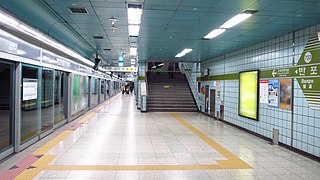
Banpo Station is a metro station on Seoul Subway Line 7 located in Jamwon-dong, Seocho-gu, Seoul. Despite its name, the station is not located in Banpo-dong, but instead in Jamwon. It has 6 entrances that they are all right side entrance and they have screen doors right before entering the train. It takes 4~8 minutes between 2 trains and next stations are Nonhyeon and Seoul Express Bus Terminal. It is only 500m long between Banpo station and two other Stations next to it. The station number is 733.
There is a small community of French people in Korea.

Samseong-Dong is an affluent neighborhood or ward of Gangnam-gu in Seoul, South Korea.

Sinsa-dong is a ward of Gangnam District, Seoul, South Korea. This district contains many department stores, hairshops, churches, boutiques, cafes and restaurants.

Jamwon-dong is a dong, neighbourhood of the greater Gangnam area Seocho-gu in Seoul, South Korea. Until 1988, Jamwon-dong was under the jurisdiction of Gangnam-gu. Jamwon-dong is popular for its mulberry trees and silkworms, whose cocoon is used to make fabric for clothing. As a legal-status neighborhood, Jamwon-dong includes Banpo 3-dong and Jamwon-dong.

Yangjae-dong is a dong, neighbourhood of the greater Gangnam area Seocho District in Seoul, South Korea. Yangjae-dong is divided into 2 different dong which are Yangjae 1-dong and 2-dong.

Hannam-dong (Korean: 한남동) is a dong, neighbourhood of Yongsan-gu in Seoul, South Korea. One of the most affluent neighborhoods in the country, it has been portrayed continuously in South Korea's popular culture as a wealthy and luxurious hotspot, and as a result of this reputation, the neighborhood has been the subject of numerous domestic films, television series, and popular music references.
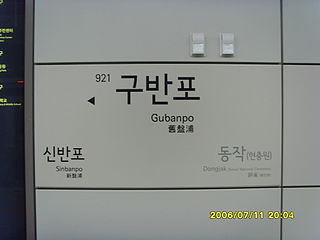
Gubanpo Station is a railway station on Line 9 of the Seoul Subway.

The French School of Seoul is a French international school in Seorae Village, a community in Banpo-dong, Seocho-gu, Seoul, South Korea. It includes kindergarten through secondary school education, which includes high school.
Dulwich College Seoul is a British international school in Banpo-dong, Seocho-gu, Seoul, South Korea. Affiliated with Dulwich College, it serves students from toddler to Year 13. It was established in 2010, opening on August 20 of that year. There are currently around 700 students, and 200 staff in the school.

Gangnam, sometimes referred to as the Greater Gangnam Area, is a geographic and cultural region in Seoul. While Gangnam can refer to the entire region of Seoul south of the Han River, the region is generally defined as consisting of the city's affluent Gangnam, Seocho and Songpa districts. Other definitions define Gangnam by the boundaries of the Gangnam Eighth School District or by the commercial zones around Gangnam Highway, Yangjae Station, Sinsa Station, Nonhyeon Station, Sinnonhyeon Station and Gangnam station. These definitions exclude the Songpa District, which has been argued to be culturally and administratively distinct from the Gangnam and Seocho districts.

